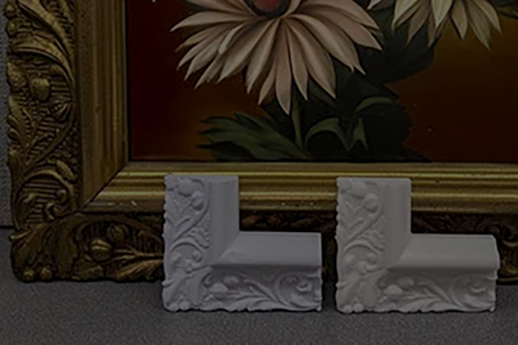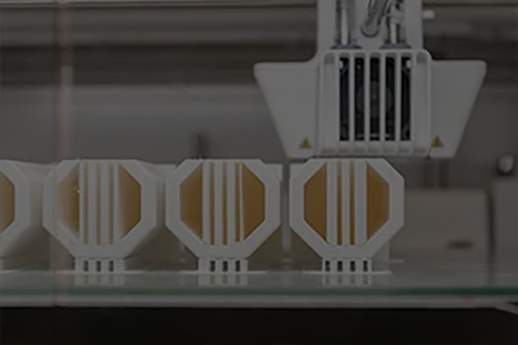3D Printed Materials

3D Printed Materials
- RIT/
- Image Permanence Institute/
- Research/
- 3D Printed Materials
Museums are experiencing an increased presence of 3D printed objects in collections and higher instances of use in preservation activities, amplifying the critical need for preservation guidelines and resources for the museum professionals caring for these objects. An incredible variety of materials can be printed with 3D technologies, and new developments within the 3D printing industry continue to push boundaries. This material diversity presents major challenges to collections stewardship given that very few studies have investigated the preservation of 3D printed objects, let alone identified the extent of material variety found within museums.
85%
Materials printed are plastics/polymers
Source: Ultimaker 3D printing sentiment index 2021
#1
USA has the highest 3D printing adoption and investment rate
Source: Ultimaker 3D printing sentiment index 2021
$37.2B
Expectation of 3D printing market by 2026
Source: Hubs additive manufacturing trends report 2021
Resources
3D Print Research and Education Collection
3D Print Research and Education Collections were created as part of an Institute of Museum and Library Services (IMLS) grant-funded research project completed 2021-2025 and titled Foundational Research to Inform Preservation Guidelines for the Creation, Collection, and Consumption of 3D Printed Objects in Museums (MG-249368-OMS-21). Six identical study collections were created that contain 3D printed samples representing a variety of different materials and printing technologies. Each collection is intended as a material reference to inform preservation practices and serve as a study collection for research and education. Two will remain at IPI, and four have been placed with conservation training programs, preservation research laboratories, and research collections across the United States. A portion of the collection consists of 18 samples printed from the same 3D file in a range of technologies and materials. These samples were designed by the research team to enable portions to be removed for testing or instrumental analysis. The remainder of the collection consists of five samples printed from a 3D scan of a frame corner that represent different 3D print processes. An additional three samples illustrate other strengths of 3D printing, including an example of 3D printed porcelain. Each collection box is accompanied by a key that identifies the samples. We are grateful to our colleagues at the Getty Research Institute, the Institute for the Preservation of Cultural Heritage at Yale, The Menil Collection, and Winterthur/University of Delaware MS Program in Art Conservation for each accepting to host a research collection and their commitment to making the collections accessible for preservation research and education activities. If you would like to schedule an appointment to view or work with a study collection, please contact IPI for additional information.
Download A Guide to the IPI 3D Print Research and Education Collection
3D Printing Glossary
This glossary defines terms used to discuss 3D printing in collecting institutions. The definitions in this glossary are reprinted with permission, from ISO/ASTM52900-21, Additive manufacturing — General principles — Fundamentals and vocabulary, copyright ISO/ASTM International. A copy of the complete standard may be obtained from ASTM, www.astm.org. Cultural heritage professionals are encouraged to use these terms consistently to facilitate common vocabulary and ease of communication between collections professionals, 3D printing service providers, and 3D print technology manufacturers.
Webinar: Introduction to 3D Printing for Cultural Heritage
Museums, libraries, and archives have seen a growing presence of 3D printed objects within the past 10-15 years, both in the context of objects entering collections and as a tool for preservation and access activities. As consumers of the technology, collecting institutions have applied 3D printing in areas such as conservation treatments, in the storage, display, and transit of objects, and education and public engagement activities. This webinar will provide an introduction to 3D printing for preservation professionals. Information covered will include an overview of 3D printing processes, terminology, commonly printed materials, and application areas within a cultural heritage setting. This webinar will also discuss findings from a recent field-wide survey on 3D printing and 3D printed objects in collecting institutions and highlight ongoing research at IPI in this area. This webinar is provided at no cost, thanks to funding from the Institute of Museum and Library Services.
Full-Length Report from 3D Printing and 3D Printed Objects in Collecting Institutions Survey
In May-June 2022, IPI conducted an online survey assessing how collecting institutions are using 3D printing and interacting with 3D printed objects and materials. The survey covered three major areas: 3D printed objects and artwork found in collections, conservation treatments of 3D printed objects, and 3D printing in preservation and access activities, including its use as a tool in conservation treatments of non-3D printed objects, exhibition and display, and collections transportation. A preliminary report containing a few of the survey highlights was released in August of 2022. The full-length report presented here provides a more comprehensive list of the questions asked in the survey and summarizes the overall survey findings.
Preliminary Findings from 3D Printing and 3D Printed Objects in Collecting Institutions Survey
As part of a new research project titled "Foundational Research to Inform Preservation Guidelines for the Creation, Collection, and Consumption of 3D Printed Objects in Museums," IPI conducted an online survey in May-June 2022 assessing how collecting institutions are using 3D printing and interacting with 3D printed objects and materials across a broad range of activities. Participants were able to choose different sections of the survey to take depending upon their professional experience with 3D printing. Highlights and preliminary findings from the survey are summarized in this initial report. A full length report will be forthcoming and posted on this page.
Collections Objects
Objects acquired in museum collections
Fine art and sculpture
Fashion and jewelry
Furniture and decorative arts
Architectural models
Storage, Display, and Transit
Materials used to house, exhibit, and move objects
Specialized/contoured packaging
Exhibit components/support structures
Preservation Interventions
Materials used for restoration/treatment of objects
Restorations
Specialized tools
Education and Engagement
Objects made by museums for primarily educational purposes
Facsimiles
Hands-on engagement and education
Accessibility (ex: exhibits for visually impaired)








